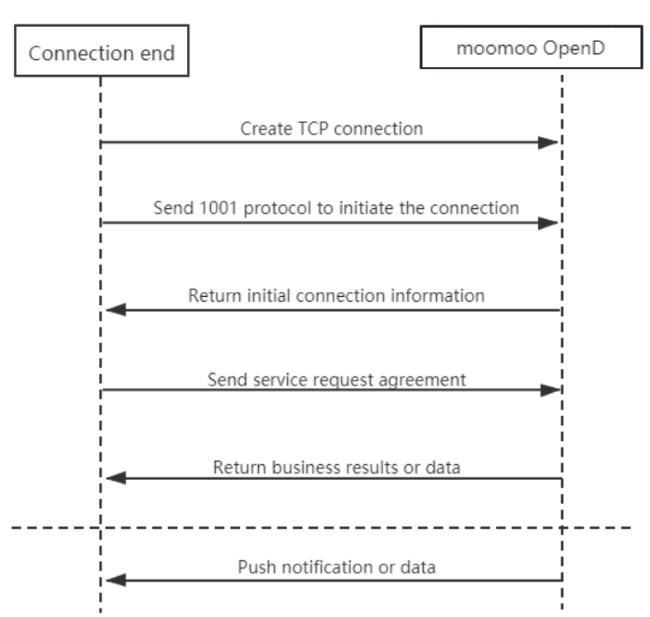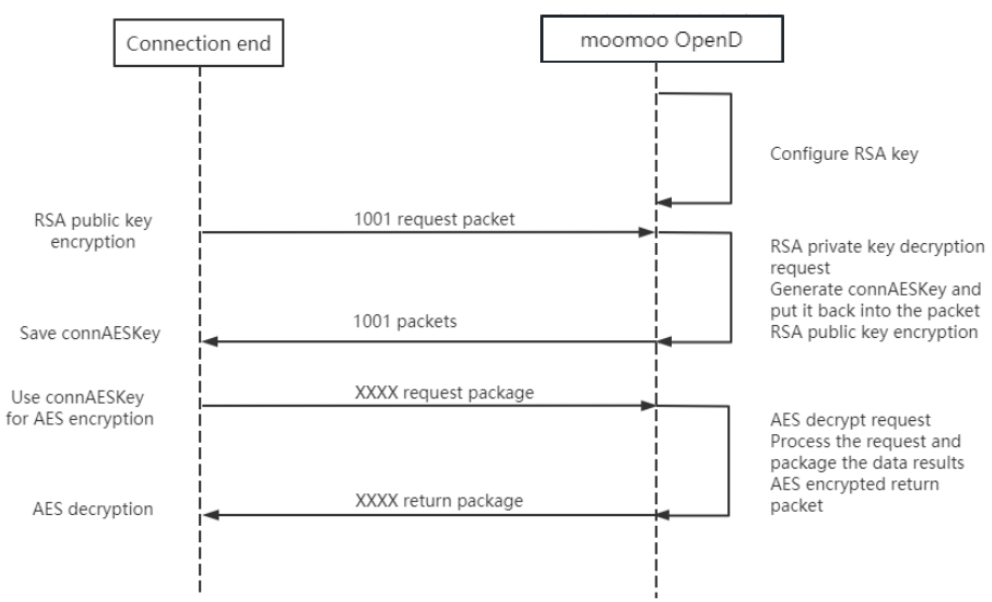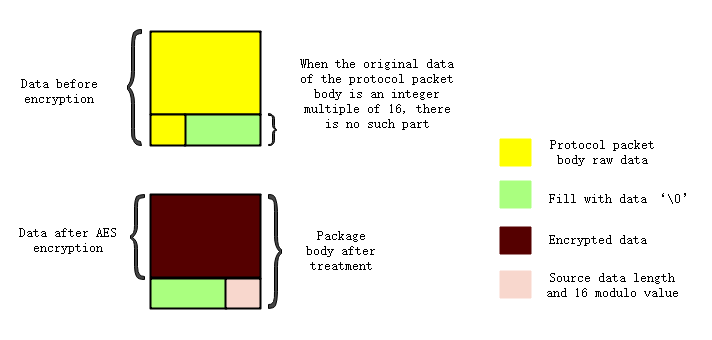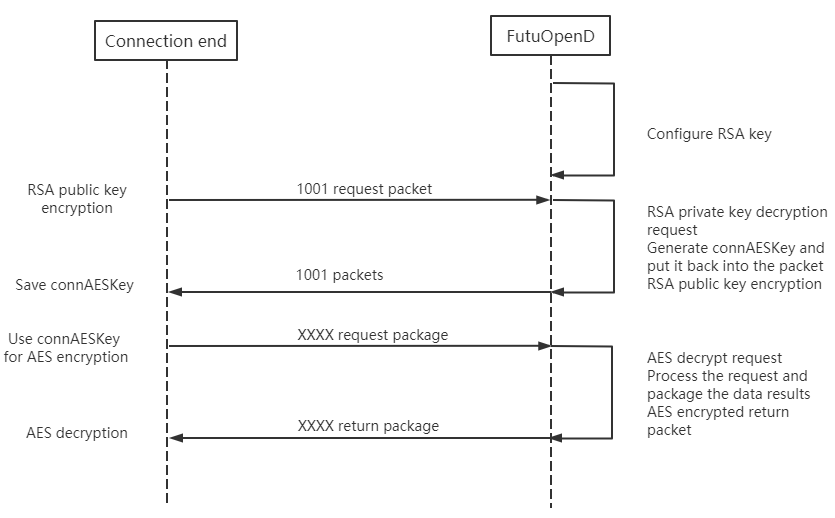# Protocol Introduction
moomoo API is an API SDK, encapsulated by moomoo including mainstream programming languages (Python, Java, C #, C++, JavaScript) to make it easy for you to call and reduce the difficulty of trading strategy development.
This part mainly introduces the underlying protocol of communication between script and OpenD service, which is suitable for users who do not use the above five programming languages.
Tips
- If you are using a programming language that is one of the five mainstream programming languages mentioned above, you can skip this part.
# Protocol Request Process
- Create a connection
- Initialize the connection
- Request data or receive pushed data
- Send KeepAlive protocol periodically to keep connected

# Protocol Design
The protocol data includes the protocol header and the protocol body. The protocol header is fixed, and the protocol body is determined according to the specific protocol.
# Protocol Header
struct APIProtoHeader
{
u8_t szHeaderFlag[2];
u32_t nProtoID;
u8_t nProtoFmtType;
u8_t nProtoVer;
u32_t nSerialNo;
u32_t nBodyLen;
u8_t arrBodySHA1[20];
u8_t arrReserved[8];
};
2
3
4
5
6
7
8
9
10
11
| Field | Description |
|---|---|
| szHeaderFlag | Packet header start flag, fixed as "FT" |
| nProtoID | Protocol ID |
| nProtoFmtType | Protocol type, 0 for Protobuf, 1 for Json |
| nProtoVer | Protocol version, used for iterative compatibility, currently 0 |
| nSerialNo | Packet serial number, used to correspond to the request packet and return packet, and it is required to be incremented |
| nBodyLen | Body length |
| arrBodySHA1 | SHA1 hash value of the original data of the packet body (after decryption) |
| arrReserved | Reserved 8-byte extension |
Tips
- u8_t refer to 8-bit unsigned integer, u32_t refer to 32-bit unsigned integer
- OpenD internal processing uses Protobuf, so the protocol format recommends using Protobuf, to reduce Json conversion overhead.
- The nProtoFmtType field specifies the data type of the package body, and the corresponding protocol type will be returned when the package is returned. The data type of the push protocol is specified by the OpenD configuration file
- arrBodySHA1 is used to verify the consistency of the requested data before and after network transmission, and must be filled in correctly
- The binary stream of the protocol header uses little-endian byte order, that is, generally there is no need to use ntohl and other related functions to convert the data
# Protocol Body
# Packet Body Structure of Protobuf Request
message C2S
{
required int64 req = 1;
}
message Request
{
required C2S c2s = 1;
}
2
3
4
5
6
7
8
9
# Packet Body Structure of Protobuf Response
message S2C
{
required int64 data = 1;
}
message Response
{
required int32 retType = 1 [default = -400]; //RetType, result of return
optional string retMsg = 2;
optional int32 errCode = 3;
optional S2C s2c = 4;
}
2
3
4
5
6
7
8
9
10
11
12
| Field | Description |
|---|---|
| c2s | Request parameter structure |
| req | Request parameters, actually defined according to the protocol |
| retType | Request result |
| retMsg | The reason for the failed request |
| errCode | The corresponding error code for failed request |
| s2c | Response data structure, some protocols do not return data if there is no such field |
| data | Response data, actually defined according to the protocol |
Tips
- The package body format type request package is specified by nProtoFmtType field from protocol header, and the OpenD initiative push format is set in InitConnect.
- The original protocol file format is defined in Protobuf format. If you need json format transmission, it is recommended to use the protobuf3 interface to directly convert to json.
- The enumeration value field definition uses signed integer, and the comment indicates the corresponding enumeration. The enumeration is generally defined in Common.proto, Qot_Common.proto, Trd_Common.proto files.
- The price, percentage and other data in the protocol are transmitted in floating point type. Direct use will cause accuracy problems. It needs to be rounded according to the accuracy (if not specified in the protocol, the default is 3 decimal places) before use.
# Heartbeat Keep Alive
syntax = "proto2";
package KeepAlive;
option java_package = "com.moomoo.openapi.pb";
option go_package = "github.com/moomooopen/mmapi4go/pb/keepalive";
import "Common.proto";
message C2S
{
required int64 time = 1; //Greenwich timestamp when the client sends the packet, in seconds
}
message S2C
{
required int64 time = 1; //Greenwich timestamp when the server returned the packet, in seconds
}
message Request
{
required C2S c2s = 1;
}
message Response
{
required int32 retType = 1 [default = -400]; //RetType, return result
optional string retMsg = 2;
optional int32 errCode = 3;
optional S2C s2c = 4;
}
2
3
4
5
6
7
8
9
10
11
12
13
14
15
16
17
18
19
20
21
22
23
24
25
26
27
28
29
30
Introduction
Heartbeat keep alive
Protocol ID
1004
Introduction
According to the heartbeat keeping alive interval returned by the initialization protocol, send the heartbeeat keep alive protocol to OpenD.
# Encrypted Communication Process
- If OpenD is configured with encryption, InitConnect must use RSA public key encryption to initialize the connection protocol, and other subsequent protocols use the random key returned by InitConnect for AES encrypted communication.
- The encryption process of OpenD draws on the SSL protocol. Considering that services and applications are generally deployed locally, we simplifies the related processes. OpenD shares the same RSA private key file with the access Client. Please save and distribute the private key file properly.
- Go to this URL to generate a random RSA key pair online. The key format must be PCKS#1, the key length can be 512, 1024, and do not set password. Copy and save the generated private key to a file, and then configure the path of the private key file to the rsa_private_key configuration item agreed upon in OpenD Configuration.
- It is recommended that users who have real trade configure encryption to avoid leakage of account and trade information.

# RSA Encryption and Decryption
- OpenD configuration Convention rsa_private_key is the path of the private key file
- OpenD shares the same private key file with the access client
- RSA encryption and decryption is only used for InitConnect requests, and is used to securely obtain symmetric encryption key of other request protocols
- The RSA key of OpenD is 1024-bit, the filling method is PKCS1, public key encryption, private key decryption, public key can be generated by private key
# Send Data Encryption
- RSA encryption rules: If the number of key bits is key_size, the maximum length of a single encryption string is (key_size)/8-11. The current number of bits is 1024, and the length of one encryption can be set to 100.
- Divide the plaintext data into one or several segments of up to 100 bytes for encryption, and the final encrypted data is spliced by all segmented encrypted data.
# Receive Data Decryption
- RSA decryption also follows the segmentation rule. For a 1024-bit key, the length of each segment to be decrypted is 128-byte.
- Divide the ciphertext data into one or several segments of up to 128 bytes for decryption, and the final decrypted data is spliced by all segmented decrypted data.
# AES Encryption and Decryption
- The encryption key is returned by the InitConnect protocol
- The ecb encryption mode of AES is used by default.
# Send Data Encryption
- AES encryption requires that the length of the source data must be an integer multiple of 16, so it needs to be aligned with ‘0’ before encryption. Record mod_len for source data length and 16 module.
- Because it is possible to modify the source data before encryption, it is necessary to add a 16-byte padding data block at the end of the encrypted data. The last byte is assigned mod_len, and the remaining bytes are assigned the value '0'. The encrypted data and additional populated data blocks are spliced as the body data to be sent in the end.
# Receive Data Decryption
- For protocol body data, first take out the last byte and record it as mod_len, then truncate the body to the 16-byte padding data block before decrypting it (corresponding to the encrypted padding extra data block logic).
- When mod_len is 0, the above decrypted data is the body data returned by the protocol, otherwise the tail (16-mod_len) length of the data used for filling and alignment needs to be truncated.



